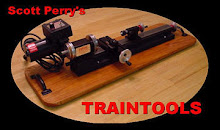From my articles in Sn3 Modeling Guide...
Welcome to the first installment of Tools of the Trade! My goal is to further our knowledge of model building tools and techniques while helping the model railroader develop his skills. It also gives me a very good reason for continuing to buy the latest tools at the local hobby shop. A tool is any device that enables the accomplishment of a job or task. This can be a hammer, screwdriver, jig (now called a positioning device by the politically correct), camera or even a pen used for taking notes. With that said, let’s jump right in and get our hands dirty.
The file is one of those items that I consider a mandatory modeling tool. For the beginner it is one of the first tools that really requires the mastering of proper techniques. For the seasoned model builder it is one of a wide variety of types and styles of metal (and plastic) shaping tools used for construction and finishing purposes. There are many types of files in the world and my tool box has quite a collection.
The basic parts of a file are as follows:
The file has an arrangement of cutting teeth or grooves along the face. There are three basic groove patterns; single cut, double cut, curved cut and rasp cut. Single cut files have one row of parallel grooves and are used for finishing work under light pressure during the stroke. Double cut files have two rows of grooves, one at about 45 degrees and another groove at about 75 degrees. This type of file is used for rapid removal of metal and for rough finishing, usually under heavy pressure. The curved cut file is a dual-purpose tool allowing for coarse shaping using the middle of the face, or for smooth finishing by using the sides of the face. The rasp cut has raised burrs and is usually used on softer materials such as wood or plastic to remove large quantities of the surface rapidly.
Files are rated by the number of teeth per inch on the face, which we call the “coarseness.” There are two types of coarseness ratings; American and Swiss Pattern. In the American rating system you have four types; coarse (the fewest teeth per inch with the most bite), bastard, second and smooth (which has the most teeth per inch and gives a finer finish). In the Swiss Pattern system you have 00 (the most coarse), 0, 1, 2, 3, 4 and 6 (the finest).
In model railroading we generally use six different classes of files. Mill files are used for sharpening tools and for general filing. They are usually single cut and slightly tapered in width, possibly being the most common of the files. Machinist’s files are designed for metal cutting and are almost always double-cut. They can be any shape over the length and are used for brass and other hobby metals. Curved tooth files can be firm or flexible and can be mounted like a hacksaw for filing corners and unusual shapes. Rasp files are used on wood and foam, such as a Surfoam tool. These hungry files take large bites and remove material very quickly, especially on foam scenery. Riffler files are smaller, specialty files that have a smooth handle and a curved filing tip. They are designed for die work and are a handy for filing in tight places. The most common file class for model railroaders is the needle file or jeweler’s file. These are simply smaller renditions of the previous classes of files. While diamond “files” are also a common item in most toolboxes, I don’t consider them a file so much as I consider them a sanding tool.
There are many different file shapes and sizes. The picture shows many of the different file profiles that are common for modelers. Round or “rat tail” files are handy for getting in small spaces. I often use the tapered square files for track laying since they easily can remove burrs on the web of the rail. Most hobby shops offer a variety pack of different shapes and sizes.
In our next column we’ll discuss the proper techniques of filing and how to choose the right file for the job. For now, grab the bastard (usually a flat mill file that is single-cut and reasonably coarse) and go to work!
Subscribe to:
Post Comments (Atom)




pangit kayo ang imong gi sulat promise kay aking nabasahan na sundogiro kay kag nawong promise w3ak kayow ka bugo pa jud promise w3ak kayow ka bugo pa jud mura kag c joel na bugo kaayow!!!
ReplyDelete